Customer Data : In today’s business landscape, collecting customer data is crucial for driving growth and improving customer experiences. However, it’s equally important to do so in an ethical manner.
With the rise of data-driven decision-making, companies are leveraging customer insights to inform their strategies. But, this must be balanced with responsible data collection practices that respect customer privacy.

By adopting ethical data collection methods, businesses can build trust with their customers and drive long-term growth. This article will explore the importance of ethical data practices and provide guidance on how to use customer data effectively.
Table of Contents
Why is customer data important for marketing?
Customer data is essential for marketing because it allows businesses to understand their audience on a deeper level, enabling more targeted and effective campaigns. By analyzing information such as demographics, preferences, buying behaviors, and online interactions, companies can tailor their messages to resonate with specific customer segments, increasing engagement and conversion rates. Moreover, customer data helps identify trends, predict future behaviors, and personalize the customer experience, which builds loyalty and long-term relationships. Without accurate data, marketing efforts risk being generic, inefficient, and costly, whereas leveraging it ethically can transform insights into actionable strategies that drive growth and enhance brand value.
How can businesses collect data without being intrusive?
Businesses can collect data without being intrusive by prioritizing transparency, consent, and value exchange with their customers. This begins with clearly informing users about what data is being collected, why it is needed, and how it will be used, typically through simple and accessible privacy notices. Companies should always obtain explicit consent, allowing customers to opt in voluntarily rather than forcing participation. Data collection can also be designed to be minimally invasive—gathering only what is necessary for improving products, services, or experiences. Offering tangible benefits in return, such as personalized recommendations, discounts, or better customer support, encourages users to share their information willingly. Finally, businesses should anonymize and aggregate data whenever possible to protect individual privacy while still gaining actionable insights. By focusing on ethical, respectful, and value-driven data practices, companies can foster trust and loyalty while collecting meaningful information.
Are You Harnessing Customer Data Ethically to Drive Your Business Growth?
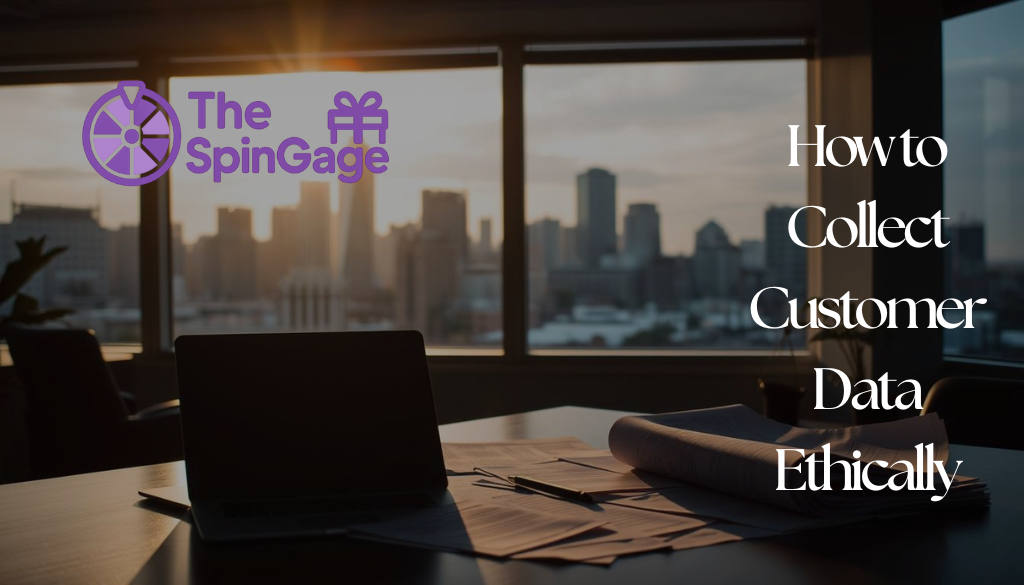
In today’s rapidly evolving digital marketplace, understanding your customers is no longer optional—it’s essential. But collecting data isn’t just about numbers and metrics; it’s about trust, transparency, and respect. Ethical data collection allows your business to gain valuable insights into customer behavior, preferences, and purchasing patterns while maintaining their privacy and confidence. From designing clear opt-in forms and crafting meaningful surveys to implementing loyalty programs and secure website analytics, every touchpoint is an opportunity to connect responsibly. By prioritizing ethical practices, you not only safeguard your customers’ personal information but also build lasting relationships that foster loyalty and long-term growth. Imagine leveraging customer insights to tailor personalized experiences, optimize product development, and make data-driven decisions that truly reflect your customers’ needs—all while maintaining the highest standards of privacy and compliance.
How does SpinGage build a database automatically?
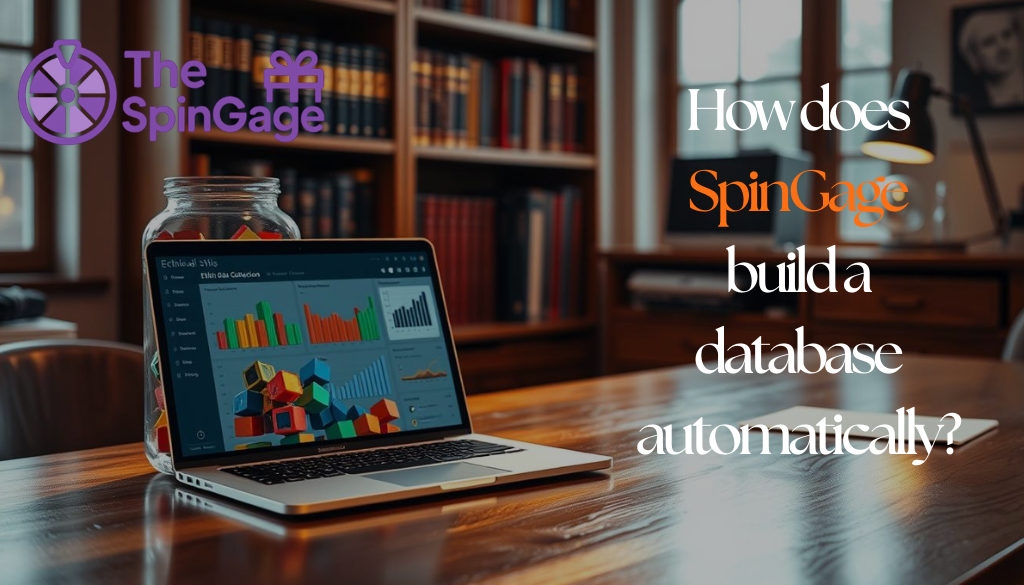
SpinGage builds a database automatically by leveraging advanced data collection and integration technologies that streamline the process of gathering and organizing information. Instead of requiring manual input, SpinGage connects directly with various digital touchpoints, such as customer interactions, website analytics, and third-party sources, to capture relevant data in real time. Using automated scripts and AI-driven algorithms, the platform categorizes, cleans, and structures this information, ensuring accuracy and consistency across the database. Additionally, SpinGage continuously updates the database by monitoring new inputs and changes, allowing businesses to maintain an up-to-date repository without ongoing manual intervention. This automation not only saves time and reduces errors but also enables businesses to gain actionable insights quickly, improving decision-making and driving growth efficiently.
How does SpinGage automate review collection?
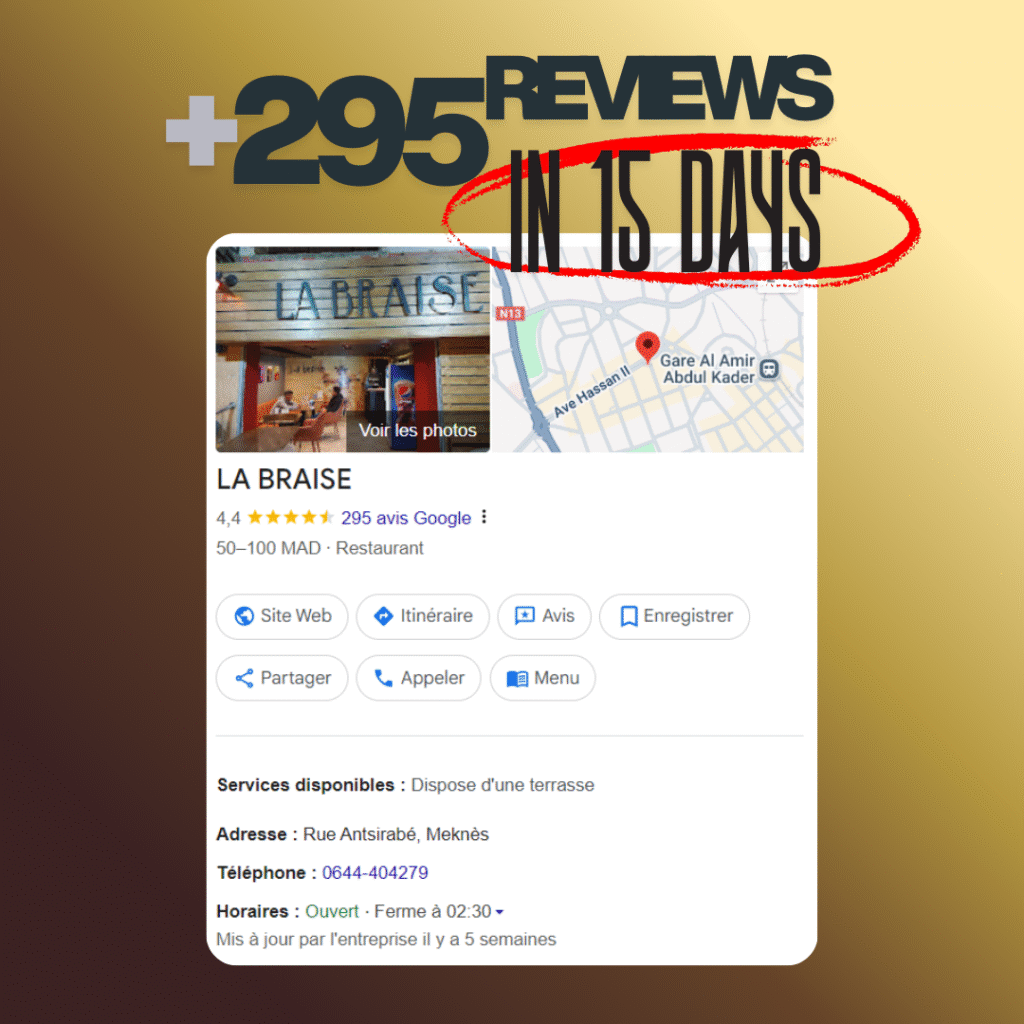
+295 REVIEWS IN JUST 15 DAYS :
Labraise is a restaurant that gained more than 295 new customer reviews and increased their income by using TheSpinGage solution.
They placed a flyer with a QR code on every table, allowing each diner to scan and spin the wheel. Labraise used a 100% winning ratio plan, where customers always won either 10% off their meal or a free soda.
This simple gamification encouraged guests to leave reviews, boosted loyalty, and kept customers coming back.

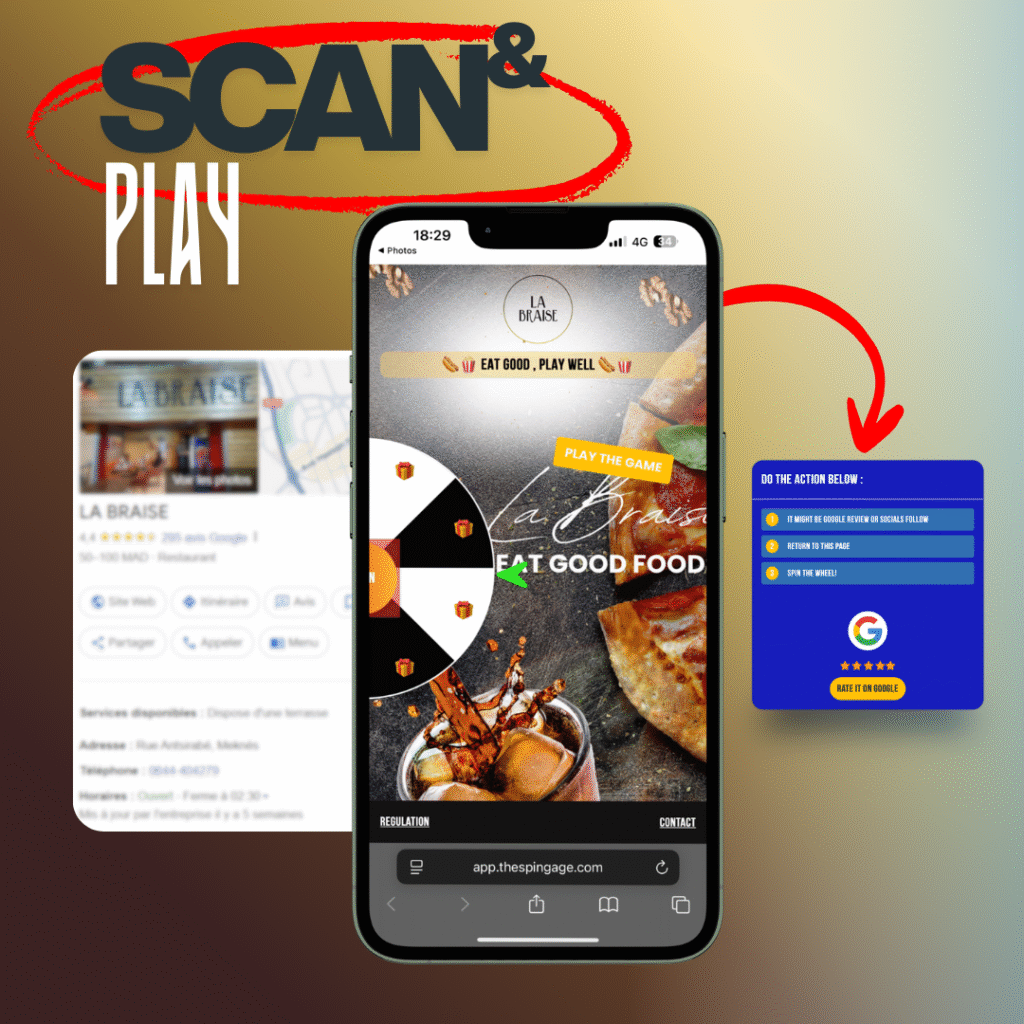
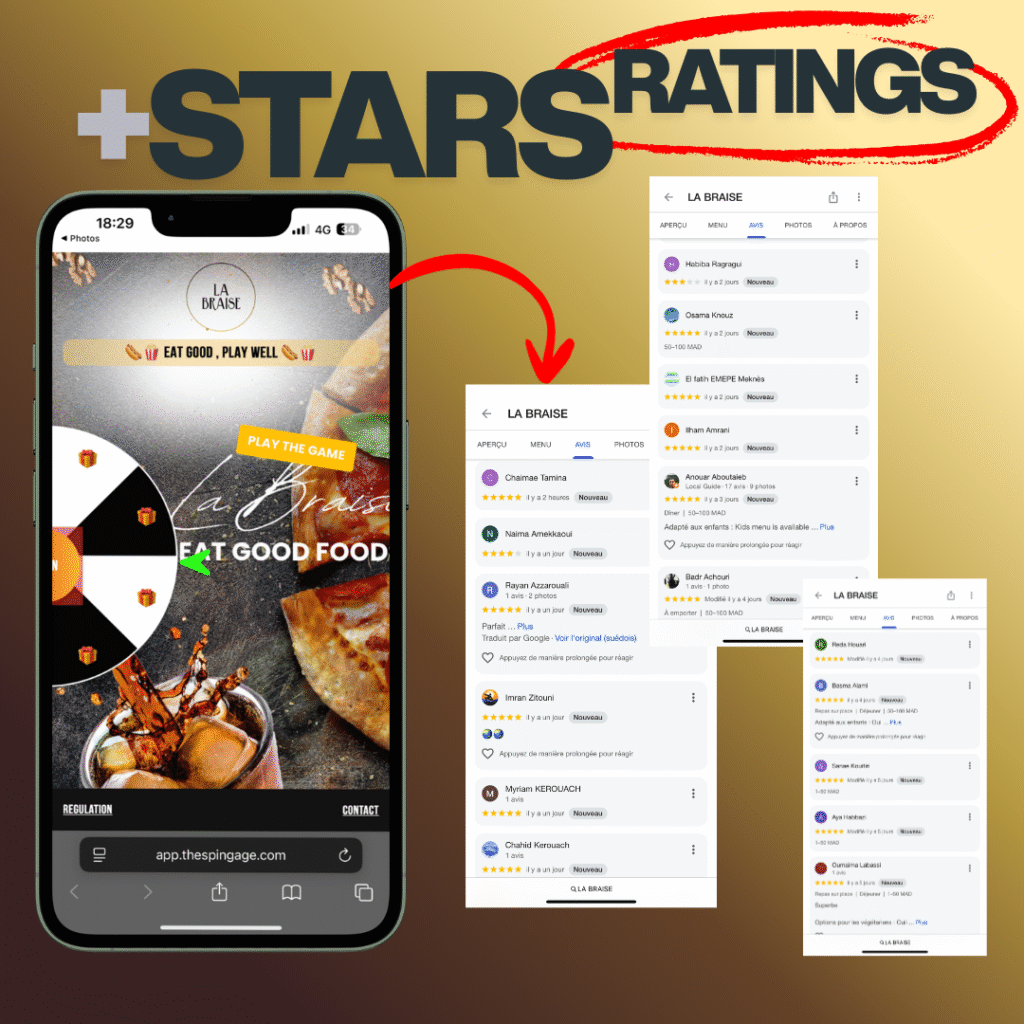
HOW IT WORKS IN 4 EASY STEPS ?
1 – Scan the QR Code
Clients simply scan the QR code placed on the table or provided directly by you.
2- Take Action First
To unlock the gameplay, they must complete the required action.
3- Spin the Wheel
Once unlocked, they spin the wheel to test their luck.
4- Win Rewards
If they win, a QR code is instantly sent to their email. If not, nothing happens. In both cases, the game is locked for 24 hours, ensuring fairness and excitement for the next try.
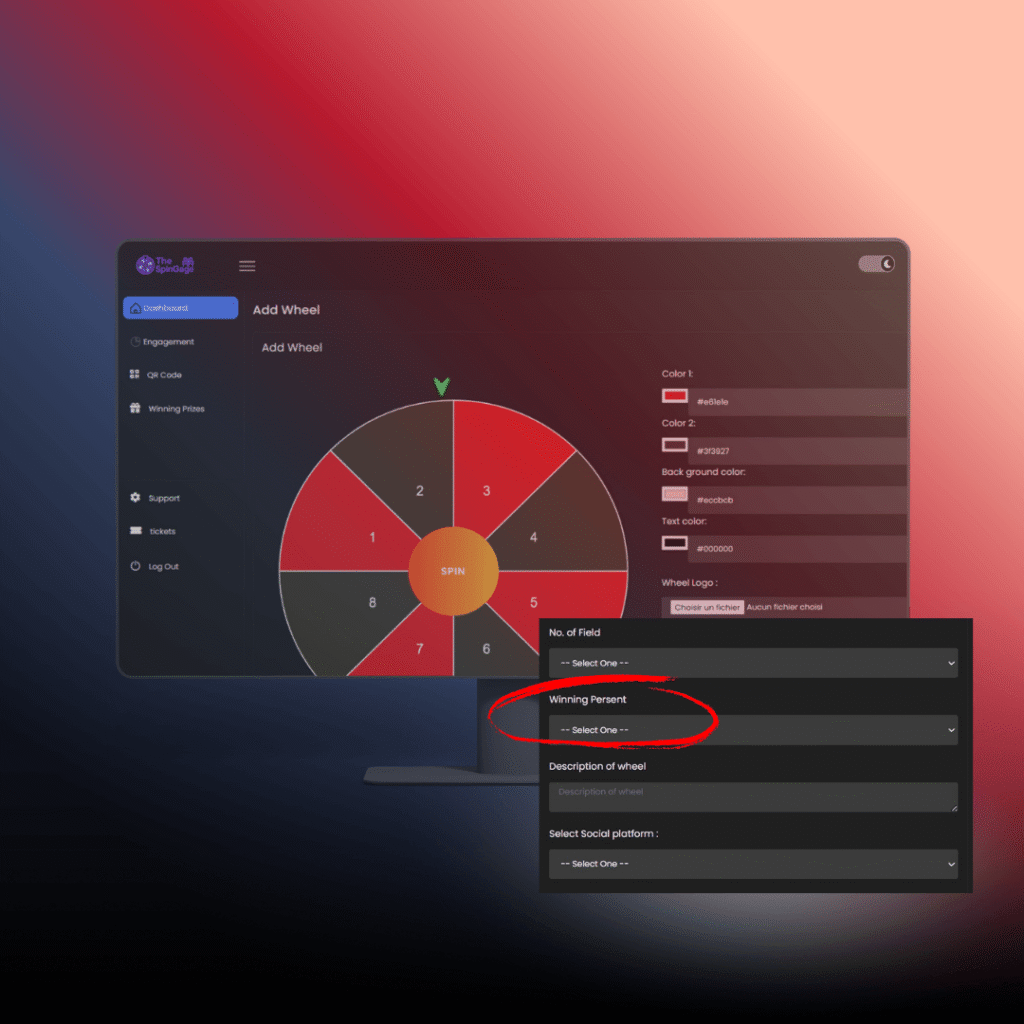


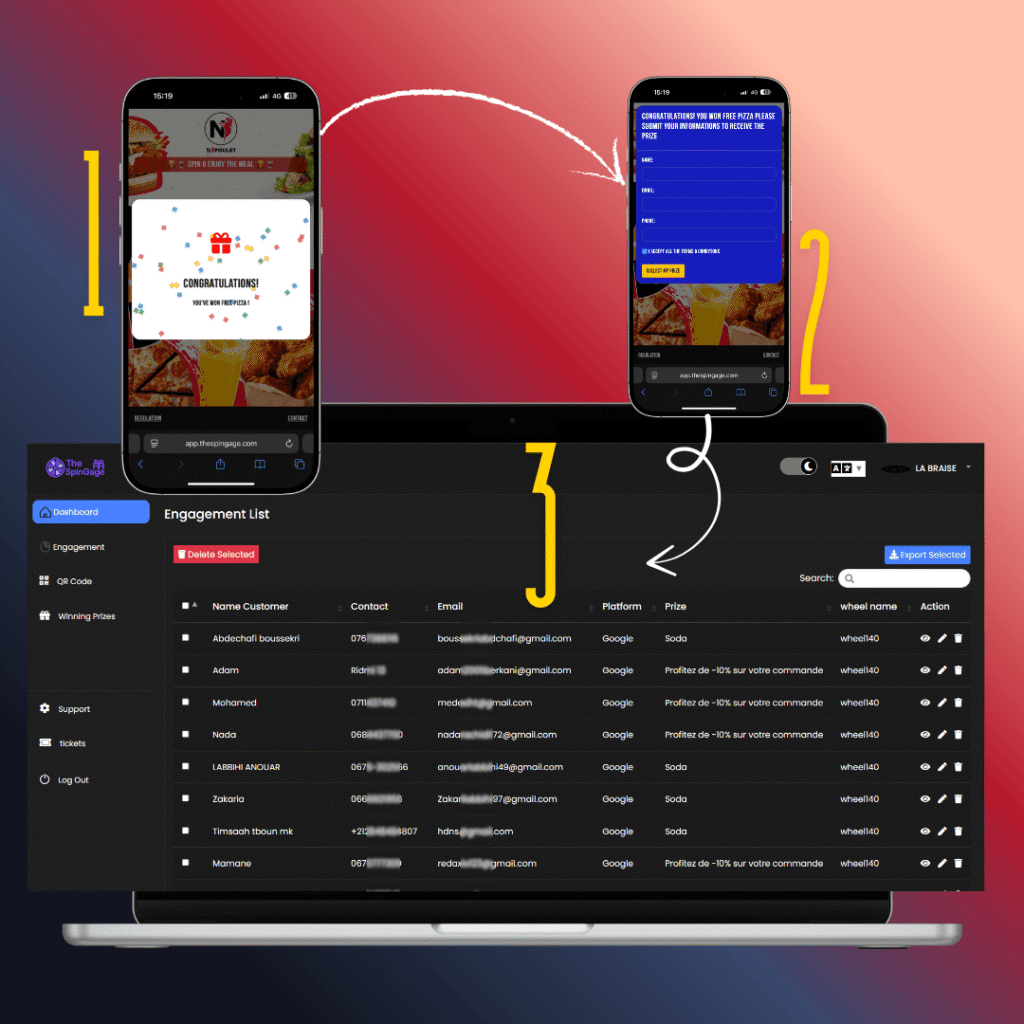
🛠️ Flexible Tracking Options
Track platform Top performing .
Track the wheel segments (number of prizes, Winner Gameplay).
Number of Plays , Track top performing wheel
Set up expiration dates for vouchers and offers.
Get Acces to LEADS , Extraxt & Modiify it .
Why You Should Opt for TheSpinGage Solution
Running a business today is not just about serving customers – it’s about creating memorable experiences that keep them coming back and spreading the word. That’s exactly what TheSpinGage delivers.
🎯 Stand Out from Your Competitors
Most restaurants, cafés, and shops rely only on discounts or word of mouth. With TheSpinGage, you turn every visit into a fun, interactive moment that clients remember and talk about.
⭐ Collect More Positive Reviews
Google reviews are the new “digital reputation.” Our system motivates clients to leave reviews in exchange for a chance to win rewards – giving you the social proof that attracts new clients effortlessly.
💌 Grow Your Customer Database
Every spin is an opportunity to collect emails and data, helping you stay connected with your clients through newsletters, promotions, and loyalty campaigns.
🔄 Boost Loyalty and Repeat Visits
Customers love rewards. By making every visit a chance to win, you encourage repeat visits, turning occasional clients into loyal fans of your business.
⚡ 100% Simple & Automated
No technical headaches. Once installed, TheSpinGage works automatically – whether through QR codes on tables, flyers, or digital screens. You just set the rules, and the system does the rest.
👉 TheSpinGage isn’t just a tool – it’s your new customer magnet.
Increase engagement, grow your reviews, and build a strong database without spending more on ads.
📲 Activate TheSpinGage today and turn visitors into loyal, returning customers!
START TODAY


SpinGage automates review collection by seamlessly integrating with your business platforms to prompt customers for feedback at the right moment. It can automatically send personalized review requests via email or SMS after a purchase or service, making it easy for customers to share their experiences. This automation not only increases the volume of reviews but also ensures consistent and timely feedback, helping businesses maintain a strong online reputation without manual effort.
Combine this with strategic local SEO practices, including keyword research, category optimization, and building citations and backlinks, and you’re positioning your business to dominate local se
At The Spin Gage, we provide expert guidance and innovative strategies to help you implement ethical data practices that elevate your business performance and build customer trust simultaneously. Take the next step toward smarter, ethical growth today.
Start Collecting Data Ethically Now →
The Value of Customer Data in Today’s Business Landscape
In today’s competitive business environment, customer data has become a crucial asset for companies looking to drive growth and improve customer satisfaction. The ability to collect, analyze, and act upon customer data effectively can significantly impact a business’s bottom line.
Why Data-Driven Decision Making Matters
Data-driven decision making is essential in modern business, as it allows companies to move beyond intuition-based strategies. By leveraging customer data, businesses can gain valuable insights into customer behavior, preferences, and needs. This information enables companies to make informed decisions, reduce risks, and identify new opportunities.
The Evolution of Data Collection Practices
The methods used to collect customer data have evolved significantly over time. Traditionally, businesses relied on surveys and focus groups to gather information. However, with the advent of digital technologies, data collection practices have become more sophisticated.
From Traditional Surveys to Digital Tracking
The shift from traditional survey methods to digital tracking has revolutionized the way businesses collect and utilize customer data. Digital tracking allows for real-time data collection, providing a more accurate and comprehensive understanding of customer behavior.
This evolution in data collection practices has enabled businesses to adopt more personalized and effective marketing strategies, ultimately driving business growth.
Understanding Different Types of Customer Data
To effectively leverage customer data, businesses must first understand the different categories into which this data falls. Customer data is typically classified into four main types: demographic, behavioral, transactional, and psychographic data. Each category provides unique insights into customer characteristics, behaviors, and preferences.
Demographic Data: Who Your Customers Are
Demographic data includes information such as age, gender, income level, education, and occupation. This data helps businesses understand who their customers are and tailor their marketing efforts accordingly.
Behavioral Data: What Your Customers Do
Behavioral data tracks customer interactions with a brand, including website visits, purchase history, and engagement with marketing campaigns. Analyzing this data reveals patterns in customer behavior.
| Data Type | Description | Example |
|---|---|---|
| Demographic | Personal characteristics | Age, Gender |
| Behavioral | Customer interactions | Purchase history, Website visits |
| Transactional | Purchase details | Purchase amount, Frequency |
| Psychographic | Customer attitudes and interests | Lifestyle, Preferences |
Transactional Data: How Customers Purchase
Transactional data encompasses details about customer purchases, including the amount spent, frequency of purchases, and payment methods used.
Psychographic Data: Why Customers Make Decisions
Psychographic data delves into customers’ attitudes, interests, and lifestyles, providing insights into why they make certain purchasing decisions.

Ethical Principles for Customer Data Collection
As businesses increasingly rely on customer data, adopting ethical data collection practices is crucial for building trust and ensuring long-term success. Ethical data collection is not just about compliance; it’s about creating a foundation of trust with your customers.
Transparency and Honesty in Data Practices
Transparency is key to ethical data collection. Businesses must be clear about what data they’re collecting, how it’s being used, and who has access to it. This transparency helps build trust with customers.
Consent and Control Mechanisms
Obtaining informed consent is crucial. Businesses should provide customers with easy-to-understand information about data collection and use, along with mechanisms to control their data.
Data Minimization Strategies
Data minimization involves collecting only the data necessary for the intended purpose. This reduces the risk of data breaches and helps maintain customer trust.
Purpose Limitation and Specificity
Avoiding Function Creep
Businesses must be specific about why they’re collecting data and limit its use to those purposes. Function creep, or using data for unrelated purposes, can erode customer trust.
| Ethical Principle | Description | Business Benefit |
|---|---|---|
| Transparency | Clear disclosure of data practices | Builds customer trust |
| Consent | Informed agreement to data collection | Enhances customer loyalty |
| Data Minimization | Collecting only necessary data | Reduces data breach risk |
| Purpose Limitation | Using data only for specified purposes | Maintains customer trust |

Legal Frameworks Governing Customer Data
In today’s data-driven economy, companies must comply with various legal frameworks to ensure the ethical use of customer data. The landscape of customer data laws is complex, with regulations varying by jurisdiction and industry.
GDPR Overview and Global Impact
The General Data Protection Regulation (GDPR) has set a new standard for data privacy, influencing global practices. Implemented in 2018, GDPR emphasizes transparency, consent, and control over personal data. Its impact extends beyond the EU, affecting any business that handles the data of EU residents.
CCPA and American Privacy Laws
In the United States, the California Consumer Privacy Act (CCPA) has been a significant step towards enhanced data privacy. It grants consumers rights over their personal data, including the right to know what data is collected and the right to opt-out of its sale. While CCPA is a state-level regulation, it sets a precedent for potential federal privacy laws.
Industry-Specific Regulations
Certain industries are subject to specific regulations due to the sensitive nature of the data they handle.
Healthcare (HIPAA)
The Health Insurance Portability and Accountability Act (HIPAA) regulates the use and disclosure of protected health information (PHI). HIPAA compliance is crucial for healthcare providers, insurers, and their business associates to maintain patient trust and avoid legal repercussions.
Financial Services (GLBA)
The Gramm-Leach-Bliley Act (GLBA) requires financial institutions to explain their information-sharing practices to customers and to safeguard sensitive data. GLBA compliance involves implementing robust security measures and providing clear privacy notices.
Understanding and complying with these legal frameworks is not only a legal necessity but also a way to build trust with customers. Non-compliance can result in significant fines and reputational damage.
As the legal landscape continues to evolve, businesses must stay informed about changes in customer data laws and regulations. This includes monitoring updates to existing laws like GDPR and CCPA, as well as emerging industry-specific regulations.
Ethical Methods to Collect Customer Data
Ethical data collection is not just a legal requirement, but a business imperative in today’s digital landscape. As businesses increasingly rely on customer data to drive growth, it’s crucial to implement methods that respect customer privacy while gathering valuable insights.
Designing Effective Opt-in Forms
Opt-in forms are a straightforward way to collect customer data, but their effectiveness depends on design and transparency. Clear and concise language about what customers are signing up for is essential. Avoid cluttering the form with too many fields, and ensure that the benefits of opting in are clearly communicated.
Creating Valuable Surveys and Feedback Mechanisms
Surveys and feedback tools can provide rich insights into customer preferences and behaviors. To be effective, they must be user-friendly and relevant. Keep surveys concise and focused on specific topics to encourage participation.
Developing Loyalty Programs with Fair Value Exchange
Loyalty programs can be an effective way to collect data while providing value to customers. The key is to ensure that the value exchange is fair and transparent. Customers should understand what data they’re sharing and how it will be used.
Implementing Transparent Website Analytics
Website analytics are crucial for understanding customer behavior. Implementing these analytics in a transparent manner involves clearly informing visitors about the data being collected and how it’s used. This includes providing clear cookie consent mechanisms.
Cookie Consent Best Practices
Cookie consent is a critical aspect of ethical data collection. Best practices include providing granular options for cookie preferences and ensuring that consent mechanisms are user-friendly and accessible.
Building Trust Through Transparent Data Practices
Transparent data practices are the foundation of building trust with customers in today’s digital landscape. By being open and honest about how customer data is collected, used, and protected, businesses can foster a sense of security and loyalty among their clientele.
Creating Clear and Accessible Privacy Policies
A clear and accessible privacy policy is essential for transparency. It should be written in plain language, avoiding legal jargon, and easily accessible from the company’s website or mobile app.

Communicating the Value Exchange to Customers
Customers need to understand what they gain from sharing their data. Businesses should clearly communicate the benefits of data sharing, such as personalized services or exclusive offers, to create a mutually beneficial relationship.
Demonstrating Robust Data Security Measures
Implementing robust data security measures is crucial for protecting customer data. This includes using encryption, secure servers, and regular security audits to prevent data breaches.
Responding to Privacy Concerns Effectively
When customers express privacy concerns, businesses must respond promptly and effectively. This involves having a dedicated support team that can address queries and resolve issues in a timely manner.
Leveraging Customer Data for Business Growth
By harnessing the power of customer data, businesses can make informed decisions that drive growth. This involves using data to understand customer behavior, preferences, and needs, ultimately leading to more effective business strategies.
Personalization Strategies That Drive Engagement
Personalization is a key aspect of leveraging customer data. By tailoring experiences to individual customers, businesses can increase engagement and loyalty. This can be achieved through targeted marketing campaigns, personalized product recommendations, and customized content.
Using Data for Product Development Insights
Customer data provides valuable insights into product development. By analyzing customer feedback, purchase history, and behavior, businesses can identify areas for improvement and develop products that meet customer needs.
Customer Experience Optimization Techniques
Optimizing customer experience is crucial for driving business growth. This involves using data to identify pain points, streamline processes, and improve overall customer satisfaction. Techniques include customer journey mapping and user experience (UX) design.
Predictive Analytics and Future Opportunities
Predictive analytics allows businesses to forecast future trends and opportunities. By analyzing customer data, businesses can identify patterns and make informed decisions about future product development, marketing strategies, and customer engagement initiatives.
Segmentation and Targeting
Segmentation and targeting are critical components of leveraging customer data. By dividing customers into distinct segments based on their behavior, demographics, and preferences, businesses can create targeted marketing campaigns that resonate with each segment.
| Segmentation Criteria | Targeting Strategies | Expected Outcomes |
|---|---|---|
| Demographic data | Personalized marketing campaigns | Increased engagement |
| Behavioral data | Targeted product recommendations | Improved customer satisfaction |
| Psychographic data | Customized content and offers | Enhanced customer loyalty |
Data Security Best Practices for Customer Information
With the rise of cyber threats, companies must adopt stringent data security protocols to safeguard customer data. A comprehensive data security strategy is crucial for protecting sensitive customer information from unauthorized access, theft, or damage.
Encryption and Access Control Implementation
One of the foundational elements of data security is encryption. By encrypting customer data, both in transit and at rest, businesses can ensure that even if data is intercepted or accessed without authorization, it will be unreadable without the decryption key. Implementing robust access controls, such as multi-factor authentication and role-based access, further enhances data security by limiting who can access sensitive information.
Employee Training and Security Awareness
Employees are often the first line of defense against cyber threats. Providing regular training on security best practices and raising awareness about phishing and other social engineering tactics can significantly reduce the risk of a data breach. Employees should understand their roles in maintaining data security and be equipped to identify and report potential security incidents.
Vendor Management and Third-Party Risk Assessment
Many businesses rely on third-party vendors who may have access to customer data. Conducting thorough risk assessments and implementing stringent security requirements for vendors can help mitigate the risks associated with third-party data handling. This includes ensuring vendors comply with relevant data protection regulations and have robust security measures in place.
Data Breach Response Planning
Despite best efforts, data breaches can still occur. Having a well-planned data breach response strategy is critical for minimizing the impact of a breach. This includes identifying the breach, containing the damage, notifying affected parties, and taking steps to prevent future breaches. A swift and effective response can help maintain customer trust and comply with legal requirements.
“Data security is not just about technology; it’s also about people and processes.” By implementing these best practices, businesses can significantly enhance their data security posture and protect customer information.
Balancing Personalization and Privacy Concerns
Striking the right balance between personalized marketing and respecting customer privacy is crucial for businesses aiming to foster trust and loyalty. In today’s digital landscape, consumers are increasingly expecting tailored experiences, but they are also becoming more aware of their privacy rights.
Understanding the Personalization Paradox
The personalization paradox refers to the phenomenon where consumers desire personalized experiences but are also concerned about the privacy implications of such personalization. Businesses must understand this paradox to navigate the complex landscape of customer expectations.
To address this, companies can implement strategies that provide value to customers while being transparent about data usage. This involves clearly communicating how customer data is collected and used.
Distinguishing Between Helpful and Intrusive Practices
Not all personalization efforts are created equal. Some practices are seen as helpful and enhance the customer experience, while others are perceived as intrusive. For instance, recommending products based on past purchases is generally seen as helpful, whereas targeting ads based on sensitive personal information can be intrusive.
| Helpful Practices | Intrusive Practices |
|---|---|
| Personalized product recommendations | Targeted ads based on sensitive information |
| Customized content based on browsing history | Using customer data for unrelated purposes |
| Special offers based on purchase history | Sharing customer data with third parties without consent |
Giving Customers Meaningful Control Options
Providing customers with control over their data and how it’s used for personalization can significantly enhance trust. This can be achieved through user-friendly privacy settings and clear communication about data practices.
Businesses can offer options such as opting out of certain data collection practices or adjusting the level of personalization they receive. This not only respects customer privacy but also makes them feel more in control.
Progressive Profiling Approaches
Progressive profiling is a technique where customer data is collected gradually over multiple interactions. This approach allows businesses to gather more detailed information about customers without overwhelming them with requests for information upfront.
By implementing progressive profiling, companies can build a more comprehensive understanding of their customers’ preferences and behaviors, enabling more effective personalization strategies.
Measuring the ROI of Ethical Customer Data Usage
To justify investments in ethical data practices, companies must learn to quantify the return on investment (ROI) of these initiatives. Measuring the ROI of ethical customer data usage involves several key steps that help businesses understand the financial and non-financial benefits of their data strategies.
Defining Key Performance Indicators
The first step in measuring ROI is to define relevant KPIs that align with the company’s data-driven goals. These may include metrics such as customer acquisition costs, retention rates, and overall revenue growth. By establishing clear KPIs, businesses can effectively evaluate the success of their ethical data practices.
- Customer Acquisition Cost (CAC): The cost associated with acquiring a new customer, which can be reduced through targeted marketing campaigns enabled by ethical data usage.
- Customer Retention Rate: The percentage of customers retained over a specific period, often improved through personalized experiences facilitated by ethical data practices.
- Revenue Growth: The increase in revenue resulting from effective use of customer data, which can be directly attributed to ethical data strategies.
Calculating Customer Lifetime Value Impact
Customer Lifetime Value (CLV) is a crucial metric that represents the total value a customer brings to a business over their lifetime. By analyzing how ethical data practices influence CLV, companies can better understand the long-term ROI of their data strategies.
Quantifying Brand Reputation Benefits
Ethical data usage can significantly enhance a brand’s reputation by demonstrating a commitment to customer privacy and transparency. While quantifying these benefits can be challenging, businesses can use metrics such as customer satisfaction surveys and Net Promoter Score (NPS) to gauge the positive impact on their brand reputation.
Compliance Cost vs. Business Value Analysis
Finally, businesses must weigh the costs associated with complying with data protection regulations against the business value derived from ethical data practices. This involves analyzing the costs of implementing data security measures, conducting privacy impact assessments, and training employees on data handling best practices, and comparing these to the benefits achieved through improved customer trust and loyalty.
By following these steps, businesses can comprehensively measure the ROI of their ethical customer data usage, making informed decisions that balance compliance requirements with business objectives.
Common Pitfalls in Customer Data Collection and Usage
As businesses increasingly rely on customer data, they must navigate several challenges to maintain ethical practices. The collection and usage of customer data are fraught with potential pitfalls that can impact both businesses and consumers if not managed correctly.
Over-collection and Data Hoarding Issues
One of the significant pitfalls is the over-collection of customer data. Businesses often gather more information than they need, which can lead to data hoarding. This not only increases the risk of data breaches but also raises privacy concerns among customers. To avoid this, companies should adopt data minimization strategies, collecting only the data that is necessary for their operations.
Misleading Consent Practices to Avoid
Obtaining genuine consent from customers is crucial. Misleading consent practices, such as using complex legal jargon or pre-ticked boxes, can undermine trust. Businesses should use clear and transparent language when seeking consent, ensuring customers understand what they are agreeing to.
Ignoring Cultural Differences in Privacy Expectations
Cultural differences play a significant role in how customers perceive privacy. Ignoring these differences can lead to missteps in data collection practices. Companies must be aware of and respect varying privacy expectations across cultures to maintain trust and compliance.
Data Quality and Integration Challenges
Ensuring data quality and integration is another challenge. Poor data quality can lead to inaccurate insights, while integration challenges can hinder a unified view of customer data.
Dealing with Incomplete or Inaccurate Data
To address these issues, businesses should implement robust data validation processes and invest in data integration technologies. This helps in maintaining high-quality data that is both accurate and complete.
Conclusion: The Future of Ethical Customer Data Usage
As technology continues to evolve, businesses must adapt their customer data practices to maintain trust and drive growth. Ethical customer data usage is no longer a choice, but a necessity in today’s business landscape. By understanding the different types of customer data and implementing ethical practices, businesses can create a win-win situation for both themselves and their customers.
The future of ethical data usage depends on striking a balance between personalization and privacy concerns. Companies like Apple and Microsoft are already setting examples by prioritizing data protection and transparency. By following their lead and leveraging customer data in a responsible manner, businesses can improve customer experiences, drive engagement, and ultimately boost revenue.
To stay ahead of the curve, businesses must continue to monitor and adapt to changing regulations, technological advancements, and shifting customer expectations. By doing so, they can ensure that their customer data practices remain ethical, secure, and beneficial to both parties. The future of ethical customer data usage is bright, and businesses that prioritize it will be well-positioned for long-term success.
FAQ
What is the importance of collecting customer data ethically?
Collecting customer data ethically is crucial for building trust with customers, maintaining a positive brand reputation, and ensuring compliance with data protection regulations like GDPR and CCPA.
How can businesses ensure transparency in their data practices?
Businesses can ensure transparency by creating clear and accessible privacy policies, communicating the value exchange to customers, and demonstrating robust data security measures.
What are the different types of customer data that businesses can collect?
Businesses can collect demographic data, behavioral data, transactional data, and psychographic data to better understand their customers and inform their marketing strategies.
How can businesses balance personalization with privacy concerns?
Businesses can balance personalization with privacy concerns by understanding the personalization paradox, distinguishing between helpful and intrusive practices, giving customers meaningful control options, and using progressive profiling approaches.
What are the best practices for securing customer data?
Best practices for securing customer data include encryption and access control implementation, employee training and security awareness, vendor management and third-party risk assessment, and data breach response planning.
How can businesses measure the ROI of using customer data ethically?
Businesses can measure the ROI of using customer data ethically by defining key performance indicators, calculating customer lifetime value impact, quantifying brand reputation benefits, and analyzing compliance costs versus business value.
What are some common pitfalls in customer data collection and usage that businesses should avoid?
Common pitfalls to avoid include over-collection and data hoarding issues, misleading consent practices, ignoring cultural differences in privacy expectations, and data quality and integration challenges.
What is the role of consent in customer data collection?
Consent plays a crucial role in customer data collection, as it ensures that customers are aware of and agree to the data being collected and used by businesses.
How can businesses implement effective opt-in forms for data collection?
Businesses can implement effective opt-in forms by making them clear, concise, and transparent, and by providing customers with meaningful control options over their data.



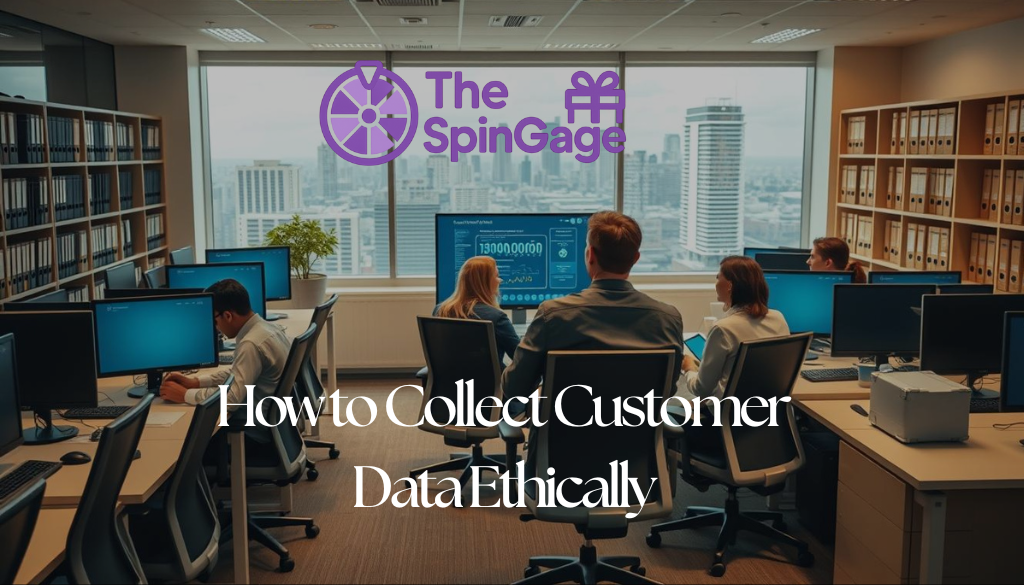


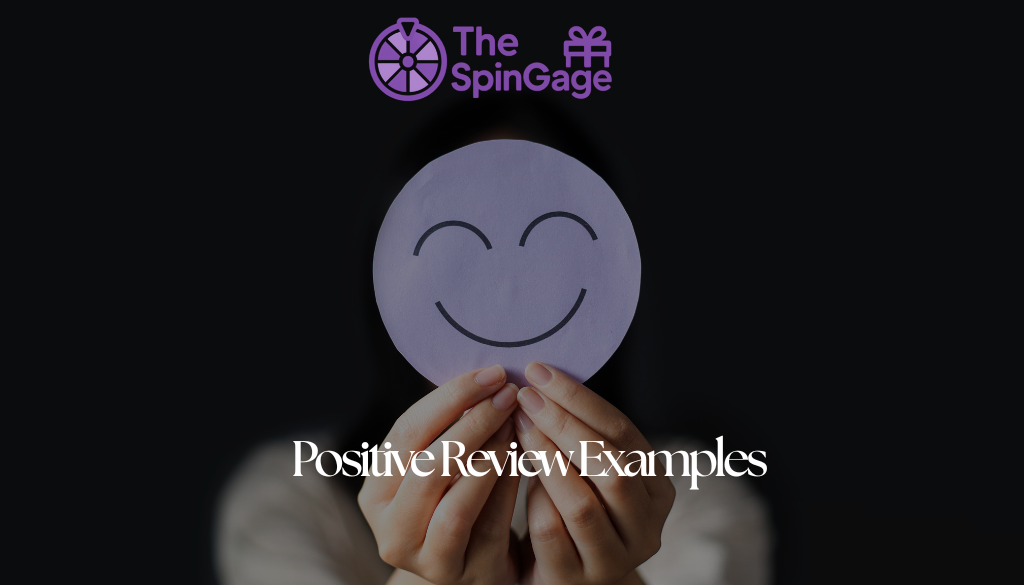
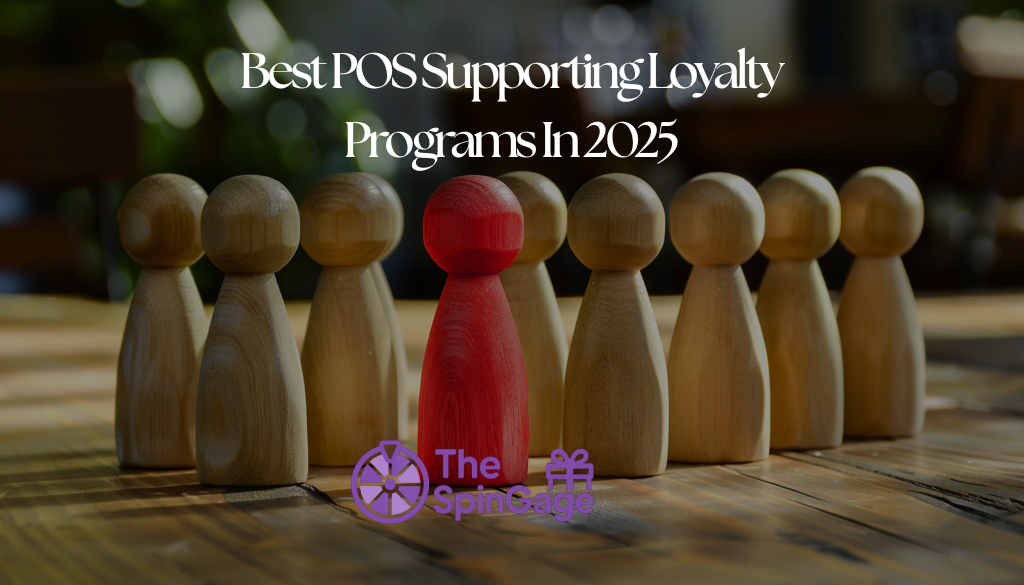


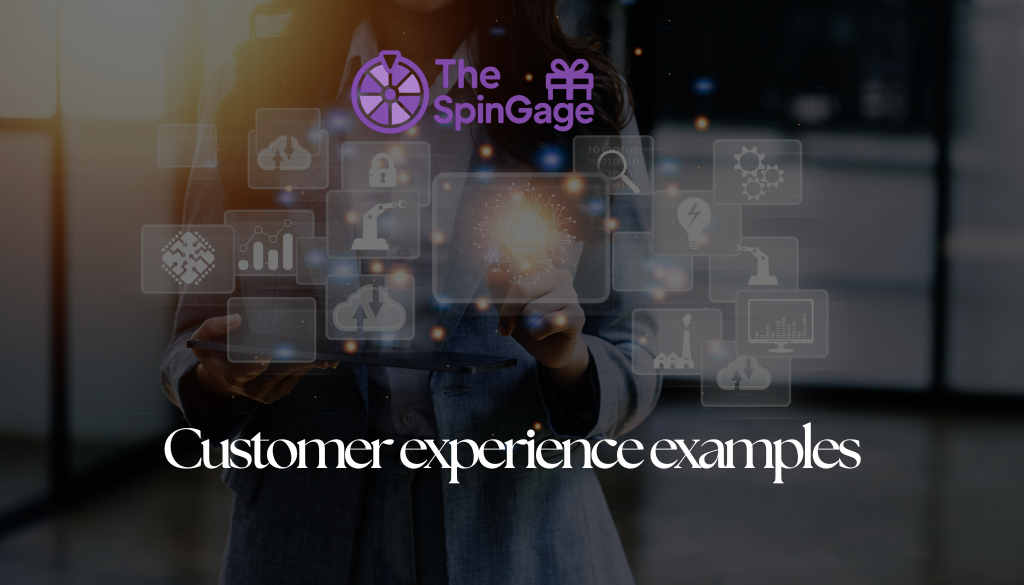

Leave a Reply